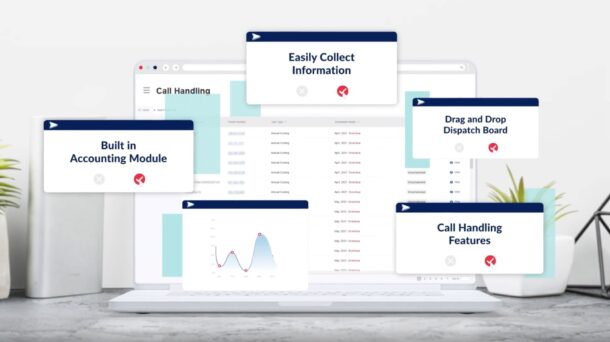By Paul Carmody
Small business owners face constant challenges in their quest for growth. In the home service industries, numerous obstacles threaten to block the path, from staffing shortages to increasing overhead expenses and competition. Add to that a few trade-specific challenges, such as fluctuations in seasonal demand and ever-changing regulations and advances in technology, and it becomes clear these businesses need a reliable way to streamline operations, improve efficiency and keep everyone on the same page.
While there’s no one-size-fits-all solution for growing a service business, there are several common pain points we hear over and over again in the field that must be addressed in order to get to that next level:
Pain Point #1: Issues Empowering Technicians in the Field
We often hear that it can be hard to track a technician’s time when they are in the field, or to outfit techs with all of the tools they need on their phone or device. When the software you’re using is lacking in features or functionality for the field or the back office, it can mean missed job notifications, slowly processed invoices and lack of customer history – all causing day-to-day headaches for the technician team.

Pain Point #2: Navigating a Mobile App vs. Back-End
Does your business have a user-friendly mobile interface for field technicians but grapple with back-end infrastructure that’s inefficient and disjointed? You are not alone. There is often a disconnect between a strong mobile app and an outdated back-end system, and a lack of integration between the two can cause communication delays between field and office staff. The unhappy result is missed appointments and disappointed customers, which leads to a tarnished company reputation.
Pain Point #3: Juggling Software Systems
Using multiple software systems that rely on an API or data sync to move data from one platform to another doesn’t always work as planned. Maintaining multiple software packages can create compatibility issues and numerous software updates that cause downtime and disruptions to critical business operations. It also adds on costs for licensing, training, and support. For technicians, switching between multiple apps to access customer details, job updates and invoicing is frustrating. Their productivity takes a hit, and the risk of error increases with manual data entry.
Prescription for Pain Relief
Fortunately, it’s possible to have a unified business management platform that streamlines day-to-day operations. Look for one that is tailored to meet the unique demands of your industry and allows for customized workflows, reports, and processes to align with your specific business requirements. Today’s best software has features designed to streamline processes, enhance business operations, help your employees make informed decisions and provide excellent customer service to your clients.
To specifically address empowering technicians in the field, provide them with a mobile app that allows them to collect payment, input customer opportunities or equipment, and invoice right from their phone or device at the jobsite.
It’s definitely time to say goodbye to paper and embrace custom digital forms that techs can access right from their mobile app. Another way to make techs (and back-office staff) happy is by eliminating the paper timecard. Time tracking in a mobile app is a must, as are digital invoices. No more waiting for the back office to email or mail an invoice; your customer can get it right away from the tech. Customers have a better experience too because they won’t have to call into the office with their payment information or wait days for an invoice to be mailed.
Once you have all that convenience in a mobile app, you want to make sure it’s connected with a powerful back-end system that answers all of your software needs in one package. A few key features to look for include:
- Accounting: integrated accounting features should be robust enough to eliminate the need for third-party accounting software or hiring an accountant to create your general ledger. The functionality should also eliminate the need for double information entry and reduce admin time by including tools like one-click digital invoicing. More accurate financial data can be at your fingertips. For instance, Successware’s accounting functionality lets users defer revenue from agreements to the period the visit occurred, leading to increased accuracy.
- Agreements: Agreement management built directly into the software will save time for call takers and dispatchers. For instance, when call takers are on the phone with a current customer, you want them to be able to see if they have an active agreement for which they need to schedule service. Dispatchers can more easily fill in jobs on the dispatch board when they can see agreement visits that need to be scheduled.
- Reporting: When operational and job data reside in the same platform as your financial data, it can do wonders for reporting. You won’t have to export data from multiple platforms to create robust reports, and if you have multiple businesses on one platform, you can consolidate financial reporting to see all data in one report. Reports in the new Successware Platform are run using Microsoft® Power BI, an industry leading platform.
There will always be pain points in business, but your business management software doesn’t have to be one of them. Do your research and find the right all-in-one solution that will reduce expenses, simplify processes and increase your revenue and profits so you can grow and scale your home service business.
 Paul Carmody has over 20 years of experience as a senior executive in Software-as-a-Service, technology-enabled services, internet infrastructure, and supply chain/manufacturing industries. He has served as a key executive in five successful exits and one IPO. He is currently President of Successware, an Authority Brands company.
Paul Carmody has over 20 years of experience as a senior executive in Software-as-a-Service, technology-enabled services, internet infrastructure, and supply chain/manufacturing industries. He has served as a key executive in five successful exits and one IPO. He is currently President of Successware, an Authority Brands company.




Join the conversation: